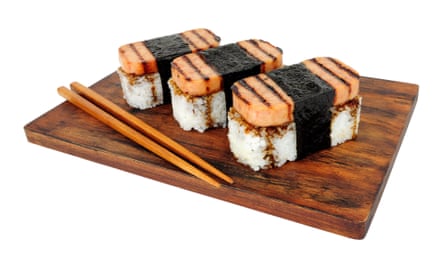
There is at least one hint of a silver lining to the cost of living crisis. That’s right, Spam is back. According to Waitrose, sales are up 36% this year, as consumers turn their backs on more expensive fresh meat.
But Spam – tinned cooked pork – need not be a compromise. Thanks to American GIs, who introduced it during the second world war to the Asia-Pacific nations, the product has become a mainstay of their cuisine. During the festival of Chuseok, South Korean supermarkets brim with elaborate Spam gift sets. In 2014, Burger King in Japan introduced a Spam and cheese burger. The biggest consumers of Spam globally are the people of the tiny Pacific island of Guam; not only do they each eat on average 16 tins a year, but Spam produces a special variety just for islanders.
Basically, you can do more with a tin of Spam than you might have thought. Here, top chefs and food experts explain how they like to use it.
Spam french fries with cheesy kimchi dipping sauce
Judy Joo, Seoul Bird, London
Spam has a long, beloved history in Korea because of the war. My mum used to feed me fried Spam and eggs for breakfast, and rice porridge studded with cubes of Spam as an after-school snack.
This is a recipe from my book Judy Joo’s Korean Soul Food. To make the cheesy kimchi dipping sauce, whisk together 1 tbsp cornflour and 340ml evaporated milk in a small saucepan over a low heat until smooth. Turn up the heat. Once the mixture has thickened and is bubbling, reduce the heat to low and stir in 125g grated cheddar and 3 to 4 tbsp chopped cabbage kimchi. Cook until smooth and velvety. Remove from heat, and keep in a warm place.
Meanwhile, cut a block of Spam lengthways into six slices, and cut each slice into four even matchsticks. Set up three dipping stations: 80g flour, two beaten eggs, and 160g panko breadcrumbs. Coat the Spam sticks with each in turn. Heat 10cm of oil in a wide heavy-based saucepan to 180C (160C fan)/350F/gas 4. Working in small batches, fry the Spam sticks until golden brown. Place on a rack to drain the oil. Serve immediately with the cheesy kimchi dipping sauce on the side.
Spam jam 3.0 sandwich
Katie Harrington, Nosh, Leeds

We are well known locally for our love of Spam, and cook many variations of our favourite porky product. Our bestseller is the Spam jam 3.0 sandwich. We toast three slices of bread, and butter them liberally. We start by smothering the bottom slice in chilli jam, and then top with fried Spam and grated cheddar cheese. Add another layer of toast, and then add two hash browns and a couple of spoonfuls of baked beans before topping with the final slice of toast.
Spam katsu curry
Simon Rimmer, Greens, Didsbury
Katsu curry works with pretty much everything, and Spam is no exception. That slightly peppery pork flavour encased in crispy panko breadcrumbs is a match made in heaven.
Cook some chopped onion, garlic and carrot until soft. Add 20g flour and 25g curry powder, then gradually stir in 750ml chicken stock, 15g honey, 15ml soy and 5g garam masala. Simmer for 20 minutes, blend until smooth, then thicken with a paste of 1 tsp cornflour mixed with 50ml water and simmer for another five minutes.
Meanwhile, cut your Spam into strips. Mix 100g flour with 5g salt and 15g curry powder. Dip the Spam strips in flour, then beaten egg, then panko and fry for three minutes. Drain and pour over the curry sauce. Serve it with some rice and chips, and enjoy the adulation.
Spam mì
Helen Graves, Serious Sandwiches newsletter

A bánh mì is one of the world’s elite sandwiches. Spam works because it is salty and highly savoury, so it contrasts with the crunchy pickles, chilli and sprigs of fresh herbs that generally make up a classic bánh mì.
Mix 2 tbsp coarse ground black pepper, 2 tbsp fish sauce, 1 tsp sesame oil and a large clove of crushed garlic together, then rub over 1cm thick Spam slices and allow to marinate for an hour. Then fry the slices in a small amount of vegetable oil until golden and crisp on both sides. Drain on kitchen paper.
Lightly warm your baguette in the oven and then smear on mayo, add the Spam, and then add coriander and mint leaves, sliced red chilli, thinly sliced red onion, de-seeded cucumber slices, carrot and daikon pickle as desired.
Spam Musubi
Ben Ebbrell, Sorted Food website

This is our recreation of a classic Hawaiian street food item, so loved [in the US state] that there is even a National Spam Musubi Day every August.
Slice the Spam into eight rectangles and sear on either side for 1 to 2 minutes in a hot pan. Place the slices on an oven tray, return the pan to the heat and add two garlic cloves, 1cm of ginger and 2 tbsp sesame oil. When fragrant, add ½ tsp chilli flakes, and 1 tbsp each of oyster sauce, sweet soy sauce, fish sauce, mirin, black vinegar and honey, and bring to the boil. Turn down the heat and simmer until reduced by half. Load the Spam slices back into the pan and flip over to coat in the sticky glaze. Remove the pan from the heat.
On a clean chopping board, slice four nori sheets in half. Lay the rectangles of nori out and load 1 heaped tbsp of cooked rice on to the bottom quarter of each sheet. Lightly moisten your hands with water and flatten the rice out so that it is the same thickness and dimensions as a piece of Spam. Lay a slice of glazed Spam on to each rice mattress, and then carefully roll the nori sheet around the rice and Spam to form your musubi.



